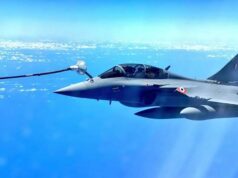Indian Navy Requires Both Nuclear – Powered Attack Submarines And Second Indigenous Aircraft Carrier

As per news report the Indian Navy is prioritising the SSN program due to the People’s Liberation Army Navy’s growing presence in the Indian Ocean. Though the report forgets to mention other foreign navies poking their nose in the IOR.
Indian Navy’s needs a minimum of 12 x SSNs for the coming decade. Therefore the project to build the first six nuclear-powered attack submarines (SSNs) has been placed before the Cabinet Committee on Security (CCS) for approval, albeit a decade too late.
The program, involves the design and construction of six SSNs, each displacing around 6,000 tones plus.. Unlike diesel-electric submarines, SSNs can remain underwater almost indefinitely and will have faster speed and more armaments. A diesel-electric submarine has to snorkel frequently to recharge its batteries which power its propellers. The process of snorkelling involves travelling just below the surface of the water with the submarine’s periscope and generator exhaust pipe above the surface.
Submarines have to come to ‘periscope depth’ and extend the snort mast above the water line so as to ingest air needed for running noisy diesel generators to charge their batteries. Snorkelling significantly increases the risk of detection.
SSNs, powered by nuclear reactors, can remain submerged for months — their endurance is limited only by the crew’s food supply and weapons expenditures. Unlike nuclear-powered ballistic missile submarines (SSBNs), SSNs don’t carry nuclear-tipped ballistic missiles. These boats are equipped with long-range anti-ship and land attack cruise missiles and torpedoes.
The navy already operates INS CHAKRA, a SSN on lease from Russia. As per reports, the IN will be getting a second SSN on lease too. The possibility of getting four more Sans on lease should not be ruled out.
The government gave the go ahead for the SSN project in 2015. Design work had begun at the Gurgaon-based Submarine Design Centre sometime around 2017 and considerable progress has been made since. The design is likely to be finalised in the next two years and the fabrication of the hull will begin after that.
The Hyderabad-based, state-owned Mishra Dhatu Nigam, has been asked to develop an indigenous special alloy for the hull of the submarine to allow it to dive much deeper than the Arihant-class SSBNs. The reactor being developed for the SSN project would be a vast improvement over the one used on Arihant class boats. It is believed to have an output of around 190 MW, a major upgrade over the 83 MW reactor on Arihant-class SSBNs.
Indian Navy is already operating 2x SSBNs as part of the Strategic Forces Command. Two more are under advance stages of completion. Soon they should be sitting silently on their deployment stations with 8000km Submarine Launched Ballistic missiles. The next series of 6XSSBNs are likely to be around 14000 tons and armed with Submarine Launched ICBM s if full 15000 Km range.
However it is being speculated, that sanctions for building 6x sans is likely to put the Indian Navy’s plan to build a 65,000-ton indigenous aircraft carrier on hold. This will be a a great set back. It is being said that the Indian Navy is prioritising the SSN program due to the People’s Liberation Army (PLA) Navy’s growing presence in the Indian Ocean. The Chinese Navy has deployed both conventional and nuclear-powered submarines in the Indian Ocean in the past. As per Naval estimates the PLA Navy currently has at least five SSNs and four SSBNs in its fleet. They also have three aircraft carriers and more to come.
Therefore it is imperative that approval for the third aircraft carrier too must bed given, with enough initial funding to start the programme.



